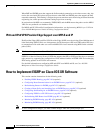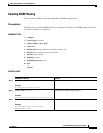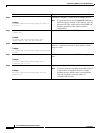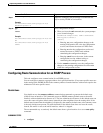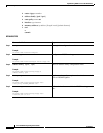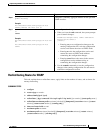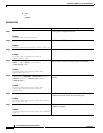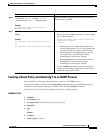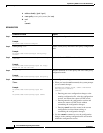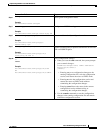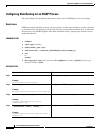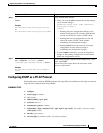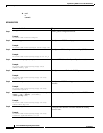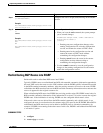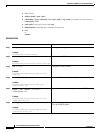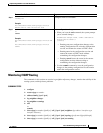
Implementing EIGRP on Cisco IOS XR Software
How to Implement EIGRP on Cisco IOS XR Software
RC-156
Cisco IOS XR Routing Configuration Guide
OL-14356-01
8. address-family {ipv4 | ipv6}
9. route-policy route-policy-name {in | out}
10. end
or
commit
DETAILED STEPS
Command or Action Purpose
Step 1
configure
Example:
RP/0/RP0/CPU0:router# configure
Enters global configuration mode.
Step 2
route-policy name
Example:
RP/0/RP0/CPU0:router(config)# route-policy
IN-IPv4
Defines a route policy and enters route-policy configuration
mode.
Step 3
set eigrp-metric bandwidth delay reliability
load mtu
Example:
RP/0/RP0/CPU0:router(config-rpl)# set eigrp
metric 42 100 200 100 1200
(Optional) Sets the EIGRP metric attribute.
Step 4
end-policy
Example:
RP/0/RP0/CPU0:router(config-rpl)# end-policy
Ends the definition of a route policy and exits route-policy
configuration mode.
Step 5
end
or
commit
Example:
RP/0/RP0/CPU0:router(config-rpl)# end
or
RP/0/RP0/CPU0:router(config-rpl)# commit
Saves configuration changes.
• When you issue the end command, the system prompts
you to commit changes:
Uncommitted changes found, commit them before
exiting(yes/no/cancel)?
[cancel]:
–
Entering yes saves configuration changes to the
running configuration file, exits the configuration
session, and returns the router to EXEC mode.
–
Entering no exits the configuration session and
returns the router to EXEC mode without
committing the configuration changes.
–
Entering cancel leaves the router in the current
configuration session without exiting or
committing the configuration changes.
• Use the commit command to save the configuration
changes to the running configuration file and remain
within the configuration session.



